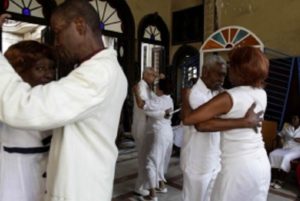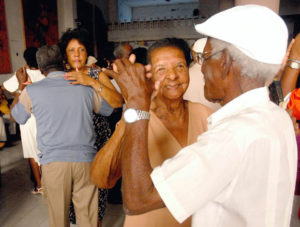It was 139 years ago, on January 1, 1879, that the musician Miguel Faílde y Pérez premiered at the Matanzas High School Las Alturas de Simpson, a rhythmic and sonorous expression that inaugurated a new type of dance, danzón, genuinely Cuban.
The inhabitants of the largest of the Antilles, without an aboriginal musical heritage but anointed with the grace of transculturation, developed a high musical capacity expressed in melodic, rhythmic, instrumental and formal aspects, which became Creole and then Cuban, made music popular and dance -conjointly with the ball and the wars of independence- one of the socio-cultural factors that define our nationality.
In the 16th century Cuba had highly qualified musicians, such as the mestizo Miguel de Velázquez; in the XVIII, classics of first line like Esteban Rooms; in the XIX Manuel Saumell, considered father of the Cuban musical nationalism, who composed a work in which Indians and blacks sang; and Ignacio Cervantes, a creator considered the most important musician of the nineteenth century. The country also had a sound manifestation like oriental sounds, played and sung for more than two centuries by the typical groups of Santiago de Cuba. They are outstanding examples that explain the creativity of our music, from which sprang the most important popular genres of the time, among them the danzón, born of Creole contradanzas.
In the mid-nineteenth century there was a proto-danzon in Cuba, choreographic dance formed by several couples provided with bows and bouquets of flowers that the blacks of Matanzas executed loudly. Miguel Faílde’s dance demonstration included a music to replace the live song of the dancers, which was released in June 1877, when he released his first four danzones, one of which was The Heights of Simpson.
The link of the danzón with the contradanzas of Manuel Saumell is observed in his introduction of 16 bars; in the second part, where the clarinet works almost always on the cinquillo; in the violin part that plays adagio; and in the closing. Meanwhile, its link with African traditions is manifested in the abundant and deliberate use of cinquillo, left by the hand of the French blacks of Santiago de Cuba. The contradanza, which dominated the music scene, was surpassed by danzón.
By adding an association of tango rhythms to the choreographic movements of dance, danzón is considered the father of Cuban dance. From its premiere to the second decade of the twentieth century it occupied the preference of island dancers and crossed borders to take root in countries such as Mexico, Venezuela and Peru, while it was nourished by all existing musical elements, regardless of their origin.
The danzón is a romantic dance, of couple, where man and woman, fused in a differentiated unit, touched the body and moved the hips sinuously. When colliding and breaking with the stereotypes of the time, it was considered a scandalous and indecent dance that, nevertheless, prevailed. The danzón enunciated by Saumell – says Alejo Carpentier – was consecrated as a new type of dance by Faílde. It predominated for more than 40 years and contributed to the process of conformation of the nationality and the nation, since Cubans of different ethnic origins and social classes danced it.
There was no event during that period of time that was not celebrated with the danzón: the advent of the Republic in 1902, on the First World War or with opera and famous zarzuela themes.
Along with the dance and dance, the danzón formed the basis of the first prototype of popular instrumental group: the typical or wind orchestra. That typical orchestra was replaced by the charanga and, in the 20th century, by the French charanga, which introduced the piano.
From the second half of the twentieth century, before the rise of the son and foxtrot of American blacks, the danzón lost ground. However, as a musical genre, it is here to stay. In 1910 José Urfé introduced new rhythmic elements of the eastern son in the Barreto’s Bombín, which together with the invention of the radio and the electric recording in the phonograph, led to his recovery. With the orchestra of Arcaño and his Wonders, the so-called danzón of new rhythm, where the flute is inspired to pleasure with great virtuosity, the rhythm is changed in the timbale and the güiro, the tumbadora is introduced in the charanga, the strings are extended, the harmony and the melody become more complex and cease the predominance of the piano as a unique solo instrument. Then, with the interpretations of Barbarito Diez and the typical Orchestra of Antonio María Romeu, the danzón influenced the origin of other Cuban dances such as the chachachá, the mambo and the pachanga.
For becoming our national dance, for its contribution to the conformation of the Cuban culture, for its presence in other musical genres that succeeded it, for its inner strength to renew itself permanently, the first of January is a day of homage to the danzón and all the glories from our dance music, from Saumell to the contemporary creators who have kept alive that musicality that distinguishes us in the world.
“EL DANZÓN”, FELIZ CUMPLEAÑOS A NUESTRO ORGULLO NACIONAL.
Hace 139 años, el primero de enero de 1879, el músico Miguel Faílde y Pérez estrenó en el liceo de Matanzas Las Alturas de Simpson, una expresión rítmica y sonora que inauguró un nuevo tipo de baile, el danzón, genuinamente cubano.
Los habitantes de la mayor de las Antillas, sin una herencia musical aborigen pero ungidos con la gracia de la transculturación, desarrollaron una elevada capacidad musical expresada en aspectos melódicos, rítmicos, instrumentales y formales, que devenida criolla y después cubana, hizo de la música popular y el baile —conjuntamente con la pelota y las guerras de independencia— uno de los factores socio-culturales definidores de nuestra nacionalidad.
En el siglo XVI Cuba tuvo músicos altamente calificados, como el mestizo Miguel de Velázquez; en el XVIII, clásicos de primera línea como Esteban Salas; en el XIX Manuel Saumell, considerado padre del nacionalismo musical cubano, quien compuso una obra en la que cantaban indios y negros; e Ignacio Cervantes, un creador considerado el músico más importante del siglo XIX. El país contó, además, con una manifestación sonora como los sones orientales, tocados y cantados durante más de dos siglos por los conjuntos típicos de Santiago de Cuba. Son ejemplos destacados que explican la creatividad de nuestra música, de la cual brotaron los más importantes géneros populares de la época, entre ellos el danzón, nacido de las contradanzas criollas.
A mediados del siglo XIX existía en Cuba un proto-danzón, baile coreográfico formado por varias parejas provistas de arcos y ramos de flores que los negros de Matanzas ejecutaban a viva voz. A esa manifestación bailable Miguel Faílde le adjuntó una música para sustituir el canto vivo de los bailarines, que vio la luz en junio de 1877, cuando dio a conocer sus primeros cuatro danzones, uno de los cuales fue Las alturas de Simpson.
El vinculo del danzón con las contradanzas de Manuel Saumell se observa en su introducción de 16 compases; en la segunda parte, donde el clarinete trabaja casi siempre sobre el cinquillo; en la parte de violín que hace de adagio; y en el cierre. Mientras, su vínculo con las tradiciones africanas se manifiesta en el uso abundante y deliberado del cinquillo,salido de la mano de los negros franceses de Santiago de Cuba. La contradanza, que dominó la escena musical, fue superada por el danzón.
Al añadirle una asociación de ritmos de tango a los movimientos coreográficos de la danza, el danzón es considerado el padre del baile cubano. Desde su estreno hasta la segunda década del siglo XX ocupó la preferencia de los bailadores de la Isla y traspasó las fronteras para arraigarse en países como México, Venezuela y Perú, a la vez que se nutrió de todos los elementos musicales existentes, sin importar su origen.
El danzón es un baile romántico, de pareja, donde hombre y mujer, fundidos en una unidad diferenciada, se tocaban el cuerpo y movían las caderas de manera sinuosa. Al chocar y romper con los estereotipos de la época, fue considerado un baile escandaloso e indecente que, no obstante, se impuso. El danzón enunciado por Saumell —dice Alejo Carpentier— quedó consagrado como nuevo tipo de baile por Faílde. Predominó durante más de 40 años y coadyuvó al proceso de conformación de la nacionalidad y la nación, ya que cubanos de diferentes orígenes étnicos y clases sociales lo bailaron.
No hubo acontecimiento durante ese lapso de tiempo que no fuese festejado con el danzón: el advenimiento de la República en 1902, sobre la primera guerra mundial o con temas de ópera y de zarzuelas famosas.
Junto a la contradanza y la danza, el danzón constituyó la base del primer prototipo de agrupación instrumental popular: la orquesta típica o de viento. Esa orquesta típica fue sustituida por la charanga y, en el siglo XX, por la charanga francesa, que introdujo el piano.
https://youtu.be/RK-pLm1TxRI
A partir de la segunda mitad del siglo XX, ante el auge del son y del foxtrot de los negros norteamericanos, el danzón perdió terreno. Sin embargo, como género musical, llegó para quedarse. En 1910 José Urfé le introdujo nuevos elementos rítmicos del son oriental en el Bombín de Barreto, que junto a la invención de la radio y la grabación eléctrica en el fonógrafo, condujeron a su recuperación, Con la orquesta de Arcaño y sus Maravillas surgió el llamado danzón de nuevo ritmo, donde la flauta se inspira a placer con gran virtuosismo, se cambia la rítmica en el timbal y el güiro, se introduce la tumbadora en la charanga, se amplían las cuerdas, la armonía y la melodía devienen más complejas y cesa el predominio del piano como instrumento solista único. Luego, con las interpretaciones de Barbarito Diez y la Orquesta típica de Antonio María Romeu, el danzón influyó en el origen de otros bailes cubanos como el chachachá, el mambo y la pachanga.
Por convertirse en nuestro baile nacional, por su aporte a la conformación de la cubanía, por su presencia en otros géneros musicales que le sucedieron, por su fuerza interior para renovarse permanentemente, el primero de enero es día de homenaje al danzón y a todas las glorias de nuestra música bailable, desde Saumell hasta los creadores contemporáneos que han mantenido viva esa musicalidad que nos distingue en el mundo.
Agencies/DDC/Dimas Castellanos/Internet Photos/ Arnoldo Varona/ TheCubanHistory.com
THE CUBAN HISTORY, HOLLYWOOD.



 > THE DANZÓN, Happy Birthday to Our National Heritage. Videos. <> EL DANZÓN, Feliz Cumpleaños a Nuestra Herencia Nacional. Videos.
> THE DANZÓN, Happy Birthday to Our National Heritage. Videos. <> EL DANZÓN, Feliz Cumpleaños a Nuestra Herencia Nacional. Videos.





